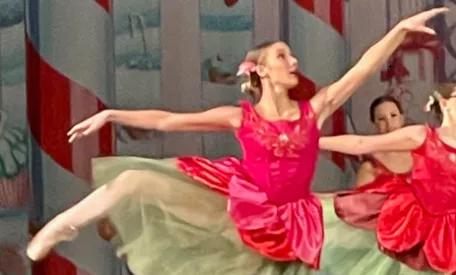Meet a teen ballerina performing in her first Nutcracker ballet since undergoing a surgery to straighten her spine.

Cleveland Clinic News Service | 216.444.0141
We’re available to shoot custom interviews & b-roll for media outlets upon request.
CCNS health and medical content is consumer-friendly, professional broadcast quality (available in HD), and available to media outlets each day.
images: 0
video: 2
audio: 1
text: 2
Content is property of Cleveland Clinic and for news media use only.
CLEVELAND – Scoliosis, an abnormal curvature of the spine, affects about seven million people in the United States. Most cases are mild and treated with bracing, while others require surgery that limits flexibility.
Aubrey Cindia, a 15-year-old ballerina from Ohio, had her dreams of dancing threatened by a severe case of scoliosis.
“He told us if the curve progressed to 25 degrees that she would need a brace to wear,” said Jamie Bolek, Cindia’s mother. “It was scary. He said if it progressed to over 40 she would probably need a surgery.”
Cindia wore a back brace for four years and continued to dance. But, while on vacation, her mom noticed her curve had changed and scheduled an appointment the next day.
“He walked in, and I could tell. I started crying, and he said the curve had progressed significantly,” Bolek recalls.
When scoliosis worsens, spinal fusion surgery — where metal rods are inserted to reposition the spine — is considered the gold standard. But, Cindia’s doctor suggested a more flexible solution.
“Tethering is an option for patients who still have growth remaining and their curves are large enough,” said Ryan Goodwin, MD, Cindia’s orthopedic surgeon with Cleveland Clinic Children’s.
The tether holds the curved side of the spine in place and prevents it from bowing further while the other side of the spine grows. Pulling on the outside of a scoliosis curve, the spine slowly straightens as it keeps growing, while also preserving back motion.
Cindia underwent a four-hour minimally invasive tethering surgery. Five months later she returned to dance, gymnastics, and aerial acrobatics.
“I feel the same as I was before I was diagnosed,” Cindia said.
“It’s way better than it was before. No brace. Dance is great,” said Bolek. “The surgery’s made it so she can do whatever she wants. The future is bright for her now because of this.”
Cindia is already a professional level ballerina and is performing in her first Nutcracker ballet since undergoing the surgery.
Dr. Goodwin said only a small subset of scoliosis patients are currently candidates for tethering, although it’s a relatively new procedure and that may evolve.